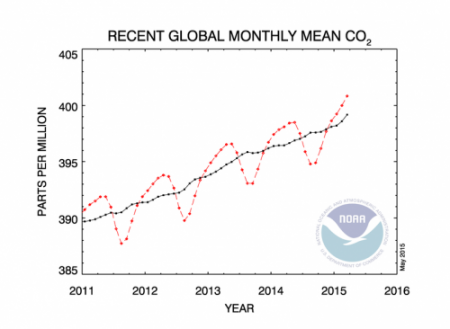May 8, 2015 – We put 32.3 billion metric tons of CO2 into the atmosphere in 2014. That’s the same amount as 2013. In some quarters that represents progress, a plateauing on carbon emissions. But the impact of continuing to pump gas into the atmosphere means CO2 continues to increase. The number should fall as the Northern Hemisphere heads into summer and plants absorb some of the CO2.
On Mauna Loa the May 6th reading for carbon dioxide reached 404.1 ppm. Measuring CO2 began when geochemist, Charles David Keeling established it as an indicator to watch because of its heat trapping properties. The first reading in 1958 was 315.7 ppm. Since then it has steadily climbed.
Keeling was the first to note seasonal oscillation in CO2 levels. His memory will be honoured this summer with the unveiling of a plaque on the campus of the Scripps Institute where he worked. The plaque, given by the American Chemical Society, recognizes Keeling’s contribution to our understanding of greenhouse gases and the part they play in atmospheric warming.
It is pretty clear that the natural absorptive capacity of the planet’s many carbon sinks are no longer able to keep up with our industrial and technical society. The next steps humanity has to take is to start getting the emission numbers down even before the nations of the world meet in Paris. An emissions flatline, which may seem like progress, is not good enough.
The news of the 400 ppm milestone being surpassed in lots of places around the world is more evidence of energy demand growing globally at rates of 1 to 2% per year. The most optimistic forecasts of renewable energy sources achieving 10% of total capacity by 2030 cannot offset the production of greenhouse gases that will come from the continued burning of coal, oil and natural gas. Only the shuttering of fossil fuel-burning power plants will alter the balance and even then we may not see a decline in the Keeling Curve for a century with our natural carbon sinks already saturated.
Related articles across the web












